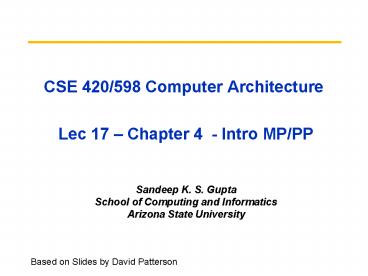CSE 420598 Computer Architecture Lec 17 Chapter 4 Intro MPPP
1 / 16
Title:
CSE 420598 Computer Architecture Lec 17 Chapter 4 Intro MPPP
Description:
CSE 420/598 Computer Architecture. Lec 17 Chapter 4 - Intro MP/PP. Sandeep K. S. Gupta ... are nearing an impasse as technologies approach the speed of light. ... –
Number of Views:78
Avg rating:3.0/5.0
Title: CSE 420598 Computer Architecture Lec 17 Chapter 4 Intro MPPP
1
CSE 420/598 Computer Architecture Lec 17
Chapter 4 - Intro MP/PP
- Sandeep K. S. Gupta
- School of Computing and Informatics
- Arizona State University
Based on Slides by David Patterson
2
Planning
- Reading Assignment Appendix C Memory Hierarchy
- Quiz Next Class on App. C
3
Outline
- MP Motivation
- SISD v. SIMD v. MIMD
- Centralized vs. Distributed Memory
- Challenges to Parallel Programming
- Introduction to (Perspective on) PP
- Conclusion
4
Uniprocessor Performance (SPECint)
3X
From Hennessy and Patterson, Computer
Architecture A Quantitative Approach, 4th
edition, 2006
- VAX 25/year 1978 to 1986
- RISC x86 52/year 1986 to 2002
- RISC x86 ??/year 2002 to present
5
Déjà vu all over again?
- todays processors are nearing an impasse as
technologies approach the speed of light.. - David Mitchell, The Transputer The Time Is Now
(1989) - Transputer had bad timing (Uniprocessor
performance?)? Procrastination rewarded 2X seq.
perf. / 1.5 years - We are dedicating all of our future product
development to multicore designs. This is a sea
change in computing - Paul Otellini, President, Intel (2005)
- All microprocessor companies switch to MP (2X
CPUs / 2 yrs)? Procrastination penalized 2X
sequential perf. / 5 yrs
6
Other Factors ? Multiprocessors
- Growth in data-intensive applications
- Data bases, file servers,
- Growing interest in servers, server perf.
- Increasing desktop perf. less important
- Outside of graphics
- Improved understanding in how to use
multiprocessors effectively - Especially server where significant natural TLP
- Advantage of leveraging design investment by
replication - Rather than unique design
7
Flynns Taxonomy
M.J. Flynn, "Very High-Speed Computers", Proc.
of the IEEE, V 54, 1900-1909, Dec. 1966.
- Flynn classified by data and control streams in
1966 - SIMD ? Data Level Parallelism
- MIMD ? Thread Level Parallelism
- MIMD popular because
- Flexible N pgms and 1 multithreaded pgm
- Cost-effective same MPU in desktop MIMD
8
Back to Basics
- A parallel computer is a collection of
processing elements that cooperate and
communicate to solve large problems fast. - Parallel Architecture Computer Architecture
Communication Architecture - 2 classes of multiprocessors WRT memory
- Centralized Memory Multiprocessor
- lt few dozen processor chips (and lt 100 cores) in
2006 - Small enough to share single, centralized memory
- Physically Distributed-Memory multiprocessor
- Larger number chips and cores than 1.
- BW demands ? Memory distributed among processors
9
Centralized vs. Distributed Memory
Scale
Centralized Memory
Distributed Memory
10
Centralized Memory Multiprocessor
- Also called symmetric multiprocessors (SMPs)
because single main memory has a symmetric
relationship to all processors - Large caches ? single memory can satisfy memory
demands of small number of processors - Can scale to a few dozen processors by using a
switch and by using many memory banks - Although scaling beyond that is technically
conceivable, it becomes less attractive as the
number of processors sharing centralized memory
increases
11
Distributed Memory Multiprocessor
- Pro Cost-effective way to scale memory bandwidth
- If most accesses are to local memory
- Pro Reduces latency of local memory accesses
- Con Communicating data between processors more
complex - Con Must change software to take advantage of
increased memory BW
12
2 Models for Communication and Memory Architecture
- Communication occurs by explicitly passing
messages among the processors message-passing
multiprocessors - Communication occurs through a shared address
space (via loads and stores) shared memory
multiprocessors either - UMA (Uniform Memory Access time) for shared
address, centralized memory MP - NUMA (Non Uniform Memory Access time
multiprocessor) for shared address, distributed
memory MP - In past, confusion whether sharing means
sharing physical memory (Symmetric MP) or sharing
address space
13
Challenges of Parallel Processing
- First challenge is of program inherently
sequential - Suppose 80X speedup from 100 processors. What
fraction of original program can be sequential? - 10
- 5
- 1
- lt1
14
Amdahls Law Answers
15
Challenges of Parallel Processing
- Second challenge is long latency to remote memory
- Suppose 32 CPU MP, 2GHz, 200 ns remote memory,
all local accesses hit memory hierarchy and base
CPI is 0.5. (Remote access 200/0.5 400 clock
cycles.) - What is performance impact if 0.2 instructions
involve remote access? - 1.5X
- 2.0X
- 2.5X
16
CPI Equation
- CPI Base CPI Remote request rate x Remote
request cost - CPI 0.5 0.2 x 400 0.5 0.8 1.3
- No communication is 1.3/0.5 or 2.6 faster than
0.2 instructions involve remote access
17
Challenges of Parallel Processing
- Application parallelism ? primarily via new
algorithms that have better parallel performance - Long remote latency impact ? both by architect
and by the programmer - For example, reduce frequency of remote accesses
either by - Caching shared data (HW)
- Restructuring the data layout to make more
accesses local (SW) - Chapter 4 mainly focuses on HW to help latency
via caches - Before going into architectural details intro
to PP.
18
Introduction to Parallel Programming
- Introduction to PP http//www.ice.gelato.org/oct0
6/pres_pdf/gelato_ICE06oct_multicore_concepts_huan
g_intel.pdf - Open MP and Structured PP http//www.ice.gelato.o
rg/oct06/pres_pdf/gelato_ICE06oct_multicore_openmp
_huang_intel.pdf































